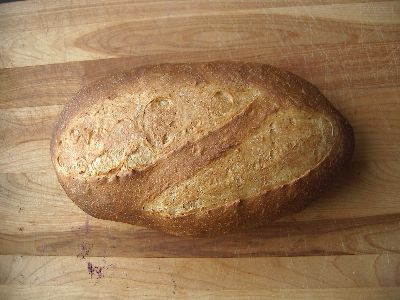Rustic Bread

I've made two batches of the Rustic Bread from Jeffrey Hamelman's Bread: A Baker's Book of Techniques and Recipes and they have turned out excellent. Pretty, too: for once my loaves are decently shaped. I'm not sure it is has so much to do with the recipe or just that, after 4 months of constant baking, I'm starting to get pretty good at this.
I love the simplicity of this one: 2 lbs flour, 1 tablespoon salt, just over 1/2 teaspoon yeast, and enough water to hydrate it all. It still amazes me how the best bread is made with the fewest ingredients.
I want to do a lesson on shaping soon, as well as one on pre-ferments. So I'm not going to cover those steps in the level of detail I should here, but I'll get enough of the recipe down that most people shouldn't have trouble following it.
Rustic Bread
Makes 2 large loavesPut the yeast in the water and stir. Mix the flour and salt together in a bowl and pour in the yeasted water. Mix until the flour is hydrated, adding more water if necessary. Cover the bowl with plastic wrap and leave the pre-ferment out at room temperature overnight (up to 16 hours... if you need more time before baking put it in the refrigerator).
Preferment:
1 lb. bread flour (3 1/2 cups)
9.5 oz. water (1 1/4 cups)
1/2 tablespoon salt
1/8 teaspoon instant yeast
Final dough:
10 oz. bread flour (2 1/2 cups)
6 oz. whole wheat or rye flour or a mixture of them (around 1 1/2 cups)
12.5 oz. water (1 1/2 cups)
1/2 tablespoon salt
1/2 teaspoon instant yeast
all of the preferment
To make the final dough, combine all of the ingredients except the pre-ferment in a mixing bowl. Chop the pre-ferment up into small pieces and mix or knead it into the final dough until they are thoroughly combined. This is quite difficult to do by hand: Hamelman assumes the baker has a mixer and can mix it for 5 minutes by machine. I mix and knead my dough by hand for about 10 minutes. At the end of that time the new and old dough aren't perfectly combined-- you can still see a few streaks of the lighter colored pre-ferment in it-- but they are sufficiently combined that loaves bake evenly.
Place the dough back in a greased bowl and ferment for 2 1/2 hours, punching down or folding the dough twice during that time.
(Folding the dough consists of taking the dough out of the bowl, spreading it out a little on a clean surface, folding it in thirds like a letter, rotating it 90 degrees and folding it up again, and then returning the dough to the bowl and covering it again. Like punching down, folding degases the dough some, but it also encourages gluten development. More on this topic in a future post.)
At the end of the fermentation, divide the dough into two pieces and preshape each into a ball. Cover with a clean towel and let each rest for 5 to 10 minutes before shaping into the final shape. Once shaped, cover the loaves with a clean towel and set aside for a final rise, approximately 1 1/4 to 1 1/2 hours.
Halfway though the final rise, begin preheating the oven to 450 degrees. If you are using a baking stone, preheat it as well.
Right before placing it in the oven, score the loaves. Place them in the oven and use whatever technique you use to create stream in the oven (squirt bottle, skillet full of hot water, etc) to encourage proper crust development.
After 20 minutes of baking, rotate the loaves 180 degrees so that they'll bake evenly. Bake until an instant read thermometer reads around 200 degrees, which took approximately 35 minutes for my batard ("football") shaped loaves.
Source: thefreshloaf.com

No comments:
Post a Comment